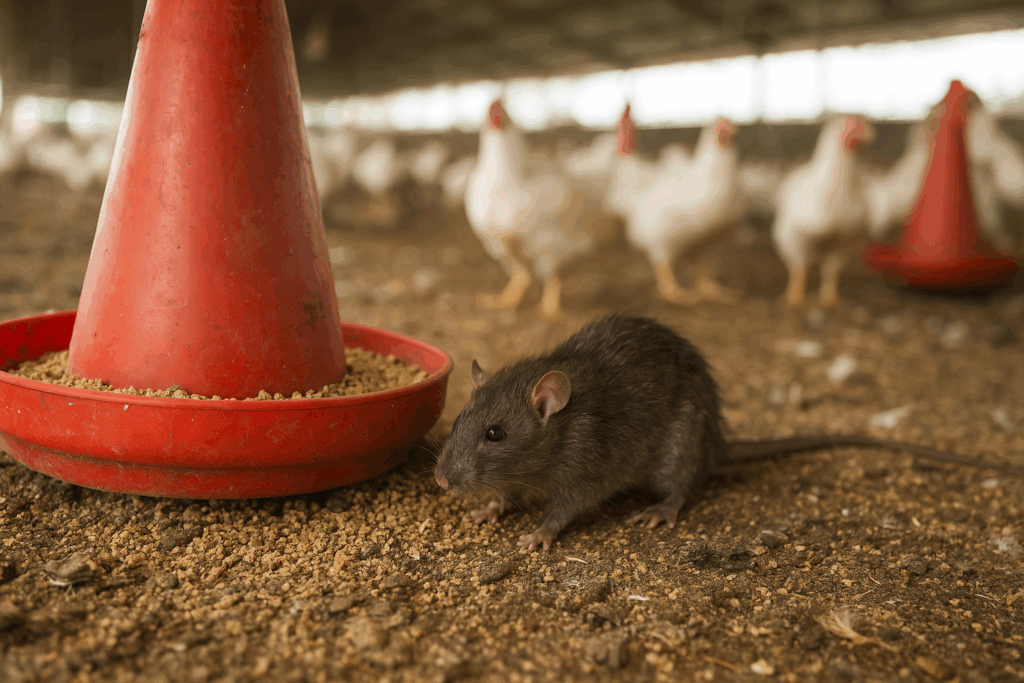🐀 Rats Threaten Poultry Profitability More Than Most Farmers Realize
In Nigeria’s growing poultry industry, farmers battle many challenges — from feed cost inflation to disease outbreaks. Yet, one of the most silent and underestimated threats to productivity is the common rat.

Animal scientists have repeatedly warned that rodents don’t just eat poultry feed — they poison, waste, and destroy much more than they consume, leading to heavy economic and biosecurity losses on farms.
🏠 How Much Feed Does a Rat Really Eat?
Scientific findings reveal that a single adult rat consumes between 25 and 46 kilograms of poultry feed per year — the equivalent of a full bag every few weeks.
However, according to the University of Tennessee Extension and Mississippi State University Poultry Research Unit, the actual economic loss is far higher.
Rats often waste or contaminate up to 10 times the amount they physically eat through trampling, scattering, and defecation.
“For every kilogram a rat eats, it may ruin between five and ten kilograms through contamination,” researchers concluded.
☣️ How Rodents Poison and Destroy Poultry Feed
Rats are not merely thieves — they are biological hazards.
Their urine and droppings contaminate feed with deadly pathogens such as Salmonella, Campylobacter, and Leptospira, all known to cause diseases in poultry and humans alike.
Contaminated feed also fosters mold growth and mycotoxin formation, which can lead to poor egg quality, reduced fertility, and low feed conversion efficiency.
Studies show that mycotoxins weaken the birds’ immune system, making them more prone to infections and vaccination failures.
🥚 Eggs and Chicks Are Also Targets
Rats don’t stop at feed bins.
Field reports and laboratory studies confirm that rodents attack nesting areas, breaking and licking eggs or carrying them away entirely.
In severe infestations, rats have been seen attacking day-old chicks, leading to panic, injuries, or death among young birds.
These nightly activities create stress conditions in the flock, reducing growth rates and egg production.
💸 Economic Consequences: Hidden Losses in Millions
A 2023 study in the Journal of Animal Science Research estimated that rodents account for up to 15% of total feed losses in small and medium-scale poultry farms across West Africa.
When feed contamination, chick mortality, and infrastructure damage are combined, even a small rat colony can cost a farm hundreds of thousands of naira annually.
Worse still, many farmers overlook this problem until the financial impact becomes severe.
🧰 Five Key Steps to Control Rodents Effectively
Animal health experts recommend an Integrated Rodent Management (IRM) strategy — not just sporadic poisoning.
- Seal entry points: Close wall cracks, drainage holes, and ventilation gaps.
- Store feed safely: Use metallic or heavy-duty plastic bins with tight lids.
- Maintain cleanliness: Remove spilled feed, stagnant water, and weeds around poultry houses.
- Set traps and bait stations: Place in dark corners, under feeders, and near walls.
- Keep records: Monitor rodent activity weekly and record bait replacement.
“A rat-free farm is not only cleaner and safer — it is more profitable,” says a poultry health consultant.
🌾 Bottom Line
Rats are not just nuisances; they are profit predators that steal feed, spread disease, and reduce flock performance.
Effective rodent control is a vital biosecurity measure every poultry farm must adopt.
For farmers, the message is clear — protect your feed, protect your flock, and protect your profit.
✍️ Author’s Note
Written by the SIM MULTIMEDIA Agriculture Desk
This article draws from findings by the University of Tennessee Extension, Mississippi State University, and the Journal of Animal Science Research (2023). It forms part of SIM MULTIMEDIA’s “Agric Focus” series — a public education campaign to promote best practices and profitability in Nigeria’s agricultural sector.
📧 Contact: contactsimng001@gmail.com
🌐 Website: www.spectroi.ng


Thanks
Very informative. Thanks